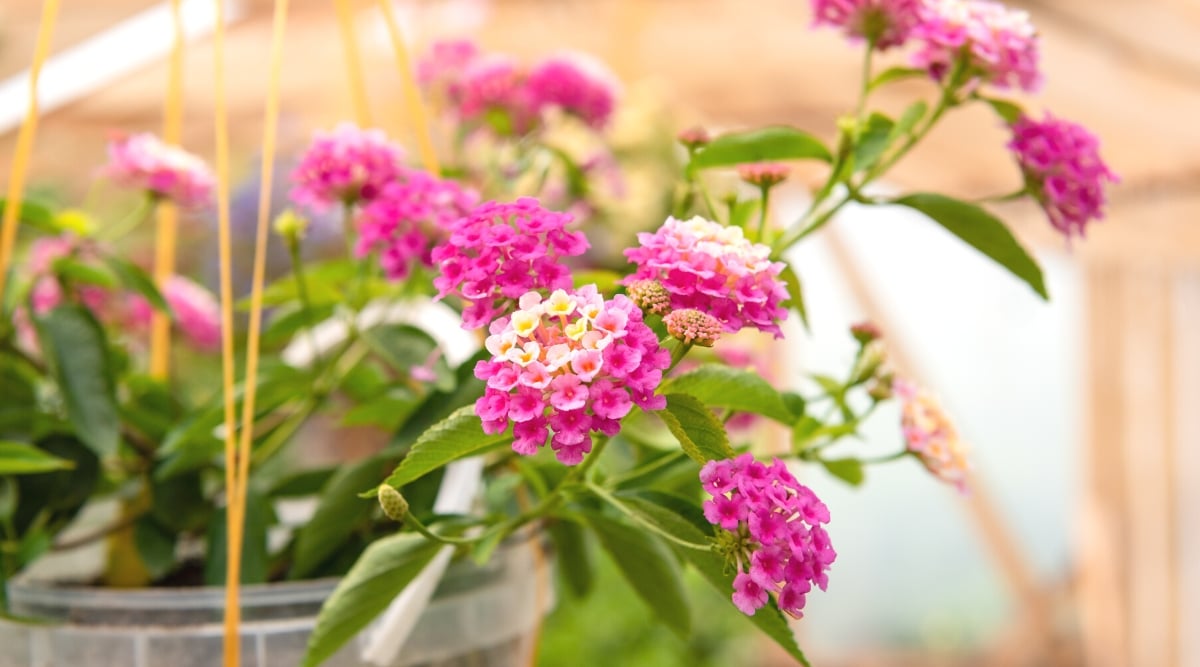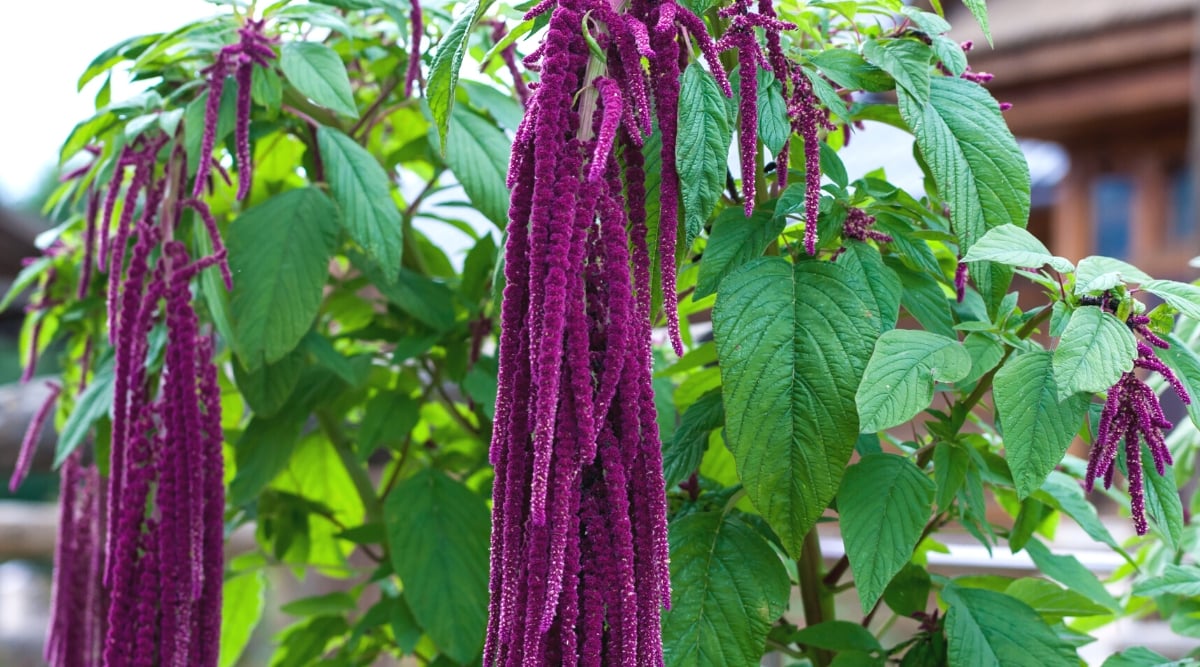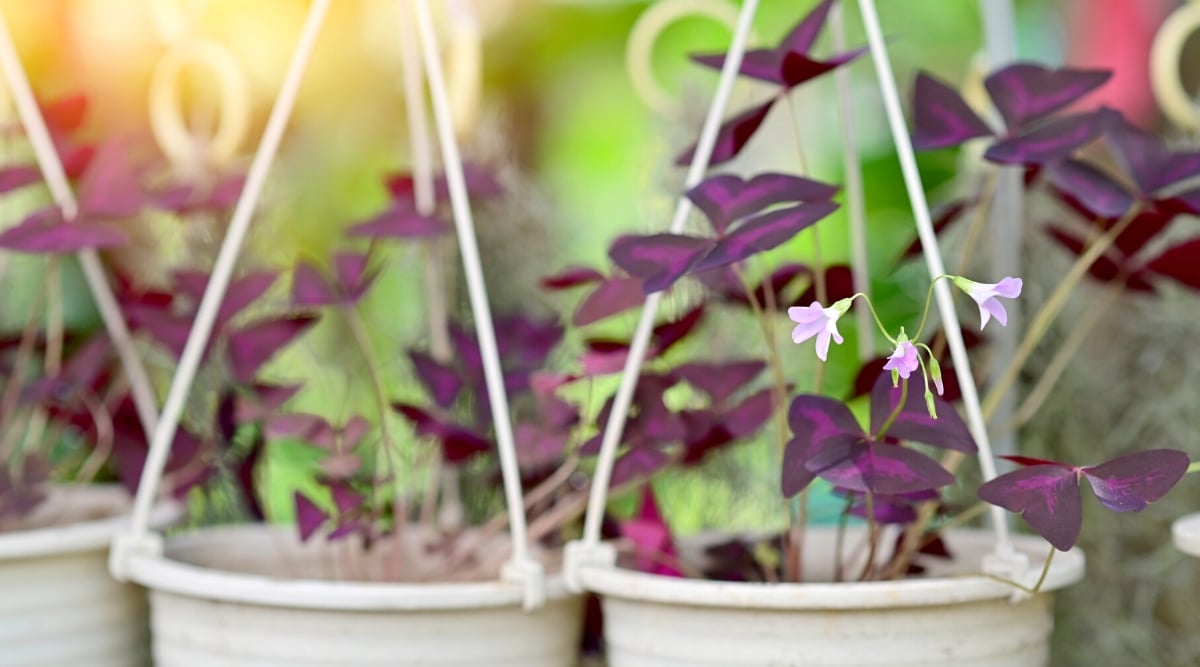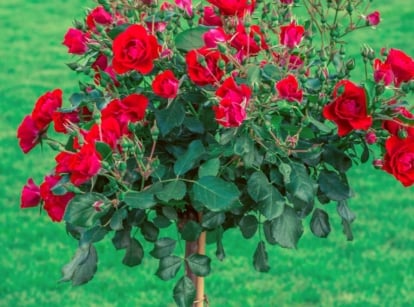27 Beautiful Plants For Hanging Baskets
Growing a hanging basket garden is more of an art than science. In this article, gardening expert Jill Drago shares some of her favorite plants you can grow in hanging baskets, both indoors and outdoors.

Contents
Hanging baskets are the perfect addition to any garden. It does not matter if you have full sun or shade; there are great plant choices for every location. You can hang your baskets outside your front door, under a covered porch, or off of a fence post. The options are endless.
So what is the problem with hanging baskets? First, buying them fully grown from a garden center can be expensive. A lot of work, preparation, and materials go into creating those beautiful hangers. But it’s just as easy to plant your own hanging baskets at home.
Here are 27 beautiful plants for you to consider planting in your hanging baskets this growing season! We’ve categorized these as thrillers, spillers, or fillers, so you know how best they’re used in your landscape.
Full Sun Loving Plants
Angelonia

- Use: Thriller
- Plant Size: 1-2 feet tall, 1- 1 ½ feet wide
- Color: Purple, White, Pink
Angelonia, also known as Angelface, is a foolproof garden beauty. The flowers bloom on tall spiked stems. The leaves are lance-shaped and stay close to the soil line. These pretty flowers bloom in shades of purple, blue, white, and pink.
This is a taller plant for a hanging basket, but it will be stunning if you plant it on its own with a spiller. There is no deadheading required for this plant. It only requires light fertilization throughout the season and is a great candidate for the occasional foliar feed.
Dwarf Morning Glory

- Use: Spiller
- Plant Size: 4-8 inches tall, trails up to 16 inches
- Color: Blue
Dwarf morning glory, with the popular variety ‘Blue My Mind,’ offers gardeners the truest blue flowers around. The foliage is dense and silvery green, while the flowers resemble star-shaped petunias. The blue flowers pair nicely with just about any color combination you throw its way, from lime green, orange, or yellow to purple or pink.
These annuals do need consistent moisture, but they love the heat. Once established, they are drought-tolerant but will grow best with consistent moisture.
Establishing these plants could take a few weeks of consistent watering. Dwarf morning glory does not require deadheading and will bloom all summer long.
Fan Flower

- Use: Spiller
- Plant Size: 8-14 inches tall, trails up to 2 feet
- Color: White, Pink, Blue
Fan flower, also known as Scaevola, is a great plant to add to your flower beds and your hanging baskets. Coming in beautiful shades of blue, pink, and white, fan flowers can be planted on their own in a hanging basket or as a spilling accent.
Fan flower is low maintenance and requires no deadheading to continue blooming all summer. This annual is also heat and drought-tolerant, making it a great choice for warmer climates.
Lantana

- Use: Filler
- Plant Size: Up to 2 feet high, Trails to 3 feet
- Color: Pink, Purple, Yellow, White, Orange, and Multi-colored
Lantana is the perfect plant for your full-sun hanging baskets. With so many colors to choose from, lantana fits in easily with most garden styles.
This plant is slightly aromatic. The flowers bloom in clusters of small flowers. While the growth habit of lantana is upright, it will creep a bit and can be used as a filler or a spiller if you do not want too much length.
Be prepared to deadhead your lantana if you want to see continued blooming. Aside from that, lantana is very low maintenance. This plant is drought and heat tolerant and can thrive through the toughest of summers.
Love-Lies-Bleeding

- Use: Thriller, Filler, Spiller
- Plant Size: 2-5 feet tall, 1-2 feet wide
- Color: Red, Pink, Green
Love-lies-bleeding is a variety of amaranth that is stunning in the landscape but even more so when planted in hanging baskets. The heart-shaped leaves are a light shade of green, while the “tassel flowers” can be in shades of red, pink, or green. These unique flowers will drip and trail over the edge of your hanging basket.
This plant can be grown from seed, or starter plants are available at most nurseries. Love-lies-bleeding is drought tolerant but will grow best with regular watering as well as fertilizing.
Aside from that, love-lies-bleeding does not require much maintenance and will remain beautiful well into the fall.
Moss Rose

- Use: Spiller
- Plant Size: 6-8 inches tall, 1- 1 ½ feet wide
- Color: Red, Yellow, Peach, Pink
Moss rose, also known as portulaca, is an extremely tough and beautiful plant. The foliage of this plant is succulent, while the brightly colored flowers are the star of the show. These flowers will open during the day and close at night.
Moss rose is very tolerant of poor soils as well as drought. The moss rose will perform at its best with consistent moisture, so don’t skip watering completely. They do not really like fertilizer and do not need deadheading to rebloom all season long.
Ornamental Oregano

- Use: Filler
- Plant Size: 8-10 inches tall, 1-2 feet wide
- Color: Green, Pink
Ornamental oregano is a perennial herb that is surprisingly beautiful. This plant produces discreet purplish pink flowers, and its foliage is a soft green with hints of pink. Do not be fooled. This type of oregano is strictly ornamental and is not for culinary purposes. You will still get hints of the traditional oregano aroma, though.
Ornamental oregano grows best in sunny locations and is relatively drought-tolerant. Do your best to keep the soil moist, however. If you are growing this plant as a perennial, cut back stems in the spring to encourage new growth.
Petunia

- Use: Spiller
- Plant Size: 6 inches to 1 foot tall,
- Color: Pink. Red, Purple, Yellow, White, Orange
The petunia is the G.O.A.T. of the hanging basket. If you have the sun and the patience to deadhead, you don’t need to plant anything else in your hangers. The petunias will do it all. Discrete green leaves and stems support the multitude of trumpet-shaped blossoms that the petunia plant will produce.
Petunias need to be fertilized regularly to produce the desired amount of blossoms. You can get ahead of this by adding some slow-release fertilizer to your hanging basket at the time of planting. But if you foliar feed your plants regularly anyway, just hit them with the hose.
Some varieties of petunias, such as supertunias, do not need to be deadheaded. If you do not have one of these varieties, you will need to stay on top of your deadheading or your plant will stop producing flowers. If the plant gets too leggy, give it a hair cut, and it will grow back nicely.
Strawberries

- Use: Filler
- Plant Size: 1-2 feet tall, 1-2 feet wide
- Color: Pink, White, Red
Why not fill your hanging baskets with beautiful flowers AND fruit? Strawberry plants produce attractive leaves and flowers with the added bonus of delicious jewel-colored fruit. Add these plants to your hanging baskets on their own or in a combo planter with coleus or ornamental grasses.
Strawberries like consistently moist soil. Many types of strawberries will rebloom all season long and do not require any deadheading (plus, if you want the fruit, you don’t want to deadhead them!). Lightly fertilize your strawberry plants all season long.
String of Pearls

- Use: Spiller
- Plant Size: 1-2 feet tall, 1-2 feet long
- Color: Green
Do not count succulents out of the hanging basket game! They are stunning and low maintenance! The string of pearls looks quite like a string of green pearls. These stems will spill out and over the edge of your basket, creating a dramatic and different look to your baskets.
It may be tricky to plant a string of pearls with other plants because you will need to grow this succulent in a succulent potting soil, and it will need to be kept only slightly moist. String of pearls is easy to propagate and a quick grower. Simply snip a stem and stick it into some succulent mix. You will see roots within a month.
Vinca Vine

- Use: Spiller
- Plant Size: 3-6 inches tall, 8 inches to 1 foot trailing
- Color: Green
Don’t overlook Vinca when you are shopping for your hanging baskets. It is a classic spiller for a reason. You can find vinca vine with solid green leaves or variegated leaves with either white or yellow variegation.
In the spring, you may see some purplish-blue flowers, but once summer rolls around, those flowers will be gone, and this plant will be grown solely for its foliage.
Vinca Vine is drought tolerant and does not require any trimming or deadheading. This plant will perfectly creep out of your hanging baskets giving it the perfect drama your basket needs.
Partial Sun or Partial Shade Loving Plants
African Daisy

- Use: Filler
- Plant Size: 1 foot tall, 1 foot wide
- Color: Red, Yellow, Pink, Purple
The African daisy, or osteospermum, is a full plant with brightly colored daisy flowers. The foliage is made up of a mound of green leaves. Each daisy is borne on its own stem. African daisies are heat tolerant and also provide bright, colorful fall interest.
This is a very low maintenance annual. African daisies do not like having wet feet. You should allow the top of the soil to completely dry out before watering again.
Because of this, be sure to plant with other drought-loving plants, such as lantana. You do not need to deadhead, but you can trim the plant at any point in the season if you feel like it!
Bacopa

- Use: Filler
- Plant Size: 4-12 inches tall, trails up to 2 feet
- Color: White, Pink, and Purple
This prolific blooming annual will be covered in perfect lightly colored flowers all season long. Plant bacopa, also known as Sutera, on its own or in a combination hanging basket. Either way, these flowers will not disappoint you. Bacopa is recommended as a filler plant but can also be used as a spiller.
Bacopa is beautifully easy to care for. There is no need to deadhead. This plant will keep pumping out new flowers for you all season long. If you encounter drought during your summer, you may notice petals and flower buds dropping from your plant. Do not worry. Bacopa will recover within a few weeks.
Black Eyed Susan Vine

- Use: Thriller or Spiller
- Plant Size: Trails up to 8 feet
- Color: White, Yellow, Orange
Black-eyed susan vine is a really fun summer-blooming vine. You can train this vine to climb up a trellis or plant it in your hanging basket as a dramatic spiller.
If you are growing this vine in your hanging baskets, it may even climb up the chains of your basket. This being said, it will also cling to nearby plants so choose a spot where there is nothing for the vine to grab onto.
Very low maintenance, the black-eyed susan vine comes in bright shades of orange or yellow as well as white. Deadheading is not a required task to keep this vine blooming all summer.
Boston Fern

- Use: Filler
- Plant Size: 2-3 feet tall, 2-3 feet wide
- Color: Green
For a classic look, try planting Boston ferns in your hanging basket. I love Boston ferns hanging from a covered porch. They grow pretty large and fill up a good amount of space. The Boston fern is made up of large fronds that are filled with small leaflets. The Boston fern will take on a beautiful upright and arching shape as it grows.
Hang your Boston fern basket in an area with indirect light. Too little sun will cause the leaflets to suffer, while too much sun will cause the leaflets to burn.
Keep the soil moist throughout the growing season, especially during hot streaks. Boston fern is a great plant choice for those that live in humid climates!
Diamond Frost

- Use: Filler
- Plant Size: 1- 1 ½ feet tall, 1- 1 ½ feet wide
- Colors: White
This variety of euphorbia is an absolute must-have in your hanging baskets, window boxes, or containers. It is the equivalent of the baby’s breath in a bouquet of roses. The foliage of diamond frost is attractive and green, while the dainty white flowers are the star of the show.
Tuck this annual into any of your hanging baskets and containers for an excellent filler, but it is also exceptional when planted on its own.
Diamond frost does not require any deadheading and is heat and drought-tolerant. You should not need to cut diamond frost back, but if it does get too large for your hanger, you can trim it back at any time, and it will continue to flower.
Dichondra

- Use: Spiller
- Plant Size: 2-6 inches tall, 2-4 feet trailing
- Color: Silver, Green
Grown for its pretty foliage, dichondra makes a really fun addition to your hanging bakers. This is a dramatic spiller, so make sure you have plenty of room for it to trail or be ready to trim the plant as needed.
Dichondra has silvery green fan-shaped leaves that decorate its long trailing stems. Add dichondra to any combination planter that needs a spiller.
Dichondra is drought and heat tolerant. You will not need to deadhead or trim this plant unless it grows too long for your space. Dichondra is a quick grower who will easily spill out of your baskets.
Ivy Geranium

- Use: Filler, Spiller
- Plant Size: 1-2 feet tall, 1-3 feet wide
- Color: White, Pink, Red
Ivy geraniums have large leaves with blossoms that resemble the standard zonal geraniums that you may be used to. The difference between these two plants is that ivy geranium has a beautiful trailing habit that lends itself very nicely to hanging baskets.
Deadhead your ivy geraniums and trim the stems if your plant looks a bit leggy. This will keep the plant tidy while encouraging new blossoms that will last you the entire summer season. Keep ivy geraniums watered but do not soak the soil and make it soggy. Do not allow the soil to dry out.
Lobelia

- Use: Filler
- Plant Size: 8-12 inches tall, 8-12 inches wide
- Color: Purple, Blue, White
Lobelia is a frilly filler for your hanging baskets. The foliage is small and accents the flowers very nicely. Lobelia offers beautiful blue flowers for gardeners that are seeking that soft hue, but it also comes in white and a deeper purple.
Lobelia has a reputation for bolting in the heat. However, there are new varieties available that are much more heat tolerant. While lobelia does not like to have wet feet, it is important to keep the soil consistently moist to aid in heat resistance.
Aside from watering, lobelia is very low maintenance and will continue blooming for you without deadheading.
Oxalis

- Use: Filler
- Plant Size: 6 inches to 1 foot high, 1 foot wide
- Color: Deep purple foliage, white or pink flowers
Oxalis is famed as an easy-to-grow houseplant, but it also makes a beautiful addition to your hanging baskets. The leaves of oxalis are similar to shamrocks and are a deep shade of purple. This plant will produce small pink or white flowers that are delicate and sweet but not the plant’s main attraction.
Oxalis does not like to dry out completely. The plant will droop. The good news is that it will typically pop right back after a good watering or rain.
Swedish Ivy

- Use: Filler
- Plant Size: 6 inches to 1 ½ feet tall,
- Color: Green
Swedish ivy is a foliage plant that can be used as a filler in your hanging baskets. As this plant grows, it will eventually creep over the sides of your container, creating a bit of a spilling effect. The leaves are green or variegated with a white edge and an attractive scallop shape.
This is an easy-to-grow annual that likes moist soil but not soggy feet. As your Swedish ivy grows, you can trim or pinch the plant back to maintain shape and size. Add Swedish ivy into any of your combination planted hanging baskets for a perfect filling accent plant with drama.
Sweet Potato Vine

- Use: Spiller
- Plant Size: Trails up to 80 inches
- Color: Green, Dark Purple, Tri-colored
Sweet potato vines make the perfect spiller for your containers and hanging baskets. This plant is grown primarily for its foliage but will produce small flowers similar to petunias. The leaves are heart-shaped and available in green, deep purple, or tricolored pink, white, and green varieties.
This plant is very easy to care for and is commonly grown indoors. It does not require deadheading or trimming unless it grows too long for your basket. The sweet potato vine pairs nicely with most other plants, adding textural and color drama.
Verbena

- Use: Thriller and Spiller
- Plant Size: Verbena bonariensis: 1-2 feet tall, 1 foot wide. Trailing verbena: 6 inches to 1 foot tall, 1-2 feet wide
- Color: Pink, Purple, White, Peach
Two popular types of verbena can be used in hanging baskets. Verbena bonariensis is an upright growing annual with strong stems and purple flowers. This would be great used as a thriller. The other variety, trailing verbena, comes in many colors and is a beautiful spiller.
These annuals are heat and drought-tolerant. You may need to deadhead any spent flowers to keep your hanging baskets blooming. There are some varieties on the market, such as superbena, that are self-cleaning and do not require you to deadhead them. Just take note of what variety you are purchasing so you can best care for your flowers.
Shade Loving Plants
Caladium

- Use: Thriller
- Plant Size: 1-2 feet tall, 1 foot wide
- Color: Green, White, Pink, Red
These beautiful foliage plants would make a stunning hanging basket all on their own. Caladium is a bulb plant and should be planted in the late spring or early summer.
If you missed this window, don’t worry. Garden centers typically have full-grown plants for you to purchase. The leaves of foliage are large and heart-shaped and come in a variety of colors and color combinations.
Caladium loves the warm weather and does not like living in soggy soil. Keep the soil moist but allow it time to dry a bit in between waterings. While caladium does best in shady conditions, you may need to keep your basket in the sun to keep the plant warm, depending on where you live.
Fuchsia

- Use: Thriller or Spiller
- Plant Size: Upright: 1-2 feet tall, 1-2 feet wide. Trailing: 4-8 inches tall, 1-2 feet wide
- Color: Pink, Purple
Fuchsia is an excellent plant for your shady hanging baskets. There is both an upright fuchsia and a trailing fuchsia. Either would work in your hanging baskets, but trailing fuchsia is probably the better option. This annual produces unique drooping flowers in bright shades of pink and purple.
Do your best to keep your fuchsia in the shade. While this annual does like some dappled sunlight, it does not like the heat. No deadheading is needed to keep your fuchsia blooming all season long while adding much-needed color to your shaded spaces.
Heuchera

- Use: Filler
- Plant Size: 1 foot tall, 1-2 feet wide
- Colors: Green, Deep Purple, Reddish Orange
Heuchera, or coral bells, is a well-loved perennial. I often like to use perennials in my containers and plant them in my flower beds in the fall. Heuchera is primarily grown for its foliage, making this plant an excellent accent to any annuals you may select.
This may be the most low-maintenance plant on my list. Aside from water, heuchera does not need you to do anything. This plant will flower, but these flowers are inconspicuous.
If you do not like them, you can deadhead them, but they might add nice interest to your hangers. Remove any unattractive leaves as you wish. Just don’t forget to plant this dependable perennial in your beds before the soil freezes.
Tuberous Begonia

- Use: Spiller
- Plant Size: 8-12 inches tall, 8-12 inches wide
- Color: Pink, Orange, Red, White
Beautiful begonia flowers will quickly fill your hanging baskets if you opt for tuberous begonias. I have used tuberous begonias in my hanging baskets more than once, and they never disappoint.
They have the same environmental needs as your standard begonias, but tuberous begonias have more decorative flowers with a trailing habit.
These plants are tolerant of heat as well as shade and do not require any deadheading. Tuberous begonias are a great option for those hangers that get a little more shade than “partial” shade.
Final Thoughts
When selecting plants for your hanging baskets, be sure to select plants, varieties, and colors you love. Keep in mind where you will be viewing your basket from.
You may not need or want a spiller if you do not have the space or if you will be enjoying your hanging basket from eye level. Similarly to a thriller, you may not have enough room for a taller plant. Each hanging basket has its own unique need and purpose!







